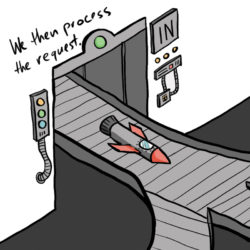Learn how NetSuite can reduce your time to close with automated intercompany eliminations.
As a business grows and expands, it’s more likely that it will operate multiple subsidiaries or acquire new businesses. Adding subsidiaries means adding accounting complexities and — in addition to reporting on individual entities — you’ll also need to start preparing consolidated financial statements. That’s where NetSuite’s automated intercompany eliminations start to come into play.
Any accountant will tell you that the consolidation process can become cumbersome when related subsidiaries start doing business with each other.
Whether it’s a parent entity charging a management fee to a subsidiary or entities selling products to one another, these intercompany transactions may need to be eliminated to avoid reporting inflated and misleading numbers on consolidated financial statements.
Eliminations help maintain the integrity of consolidated financial statements, but like I mentioned, this process can be complex and can create speed bumps during period close.
PREVIOUS POST — Simple Guide to NetSuite Grid Order Management
The Challenges
The process of eliminating intercompany transactions can have many moving parts that the accounting team must keep track of and the consequences of incorrectly booking these entries can be costly, including having to restate your financials.
The elimination process can be daunting, as your accounting team potentially juggles the following responsibilities:
- Tracking and remembering which transactions need to be eliminated each period;
- Calculating the amounts that need to be eliminated;
- Correctly debiting and crediting multiple entries to both income statement and balance sheet accounts for each subsidiary;
- Considering foreign exchange implications for international subsidiaries as well as managing additional statutory books; and
- Reconciling account balances to confirm the correct amounts are reflected in each account for each subsidiary.
When these intercompany transactions and elimination entries are booked manually, there is a higher probability that a journal entry will be incorrectly posted or all together missed. These errors can be hard to catch and can lead to time consuming reconciliations that delay period close or even worse, incorrect financial statements.
To help streamline the elimination process and avoid intercompany accounting errors, NetSuite offers functionality for automated intercompany eliminations, which we will cover in this post.
RECOMMENDED POST — NetSuite SuiteBilling – Billing the way you want it
NetSuite’s Solution
NetSuite’s Automated Intercompany Management feature is a suite of functionality that enables you to manage intercompany transactions and automatically generate elimination journal entries.
With this functionality enabled, you can create a range of intercompany transactions including Intercompany Sales Order and Purchase Orders (along with the corresponding Invoices and Bills), Intercompany Transfers, and Intercompany Journal Entries.
In addition to being able to create the intercompany entries, NetSuite will track which transactions need to be eliminated based on how you set up a few things in your account and will create the elimination entry for your accounting team as part of the close process.
This article focuses on automating intercompany eliminations, but click on the post linked below to learn more about the other available intercompany functionality.
RELATED POST – NetSuite Tutorial: How to Streamline Your Intercompany Transactions
Automated Intercompany Eliminations: An Overview
As a high-level overview, the elimination process in NetSuite works as follows:
- Your team will enter intercompany transactions as intercompany sales invoices and vendor bills throughout the month. These transactions will automatically post to accounts that have been flagged as intercompany accounts, and have transaction lines marked as candidates for intercompany elimination. Advanced intercompany journal entries (AICJE) can also be used instead to enter transactions during a period, giving you the flexibility to manually flag lines for elimination if you’d like.
- When it’s time to close a period, somebody in your accounting team will run the intercompany elimination close task. This will kick off a process in NetSuite that will automatically create the elimination journal entries for all flagged transaction and journal entry lines. NetSuite will also create auto-reversing journal entries in the next period for all flagged journal lines posted to the Intercompany Receivables and Intercompany Payables accounts.
- Once the task is complete, your accounting team can review the Intercompany Elimination report to confirm eliminations posted correctly and account balances are accurate.
Sound easy enough? That’s because it is. However, there is some setup that has to happen before getting to this point so let’s walk through the main elements of the setup process.
NEXT POST — NetSuite Accounting: Simplify Your Financial Reporting
Setup
Setting Up an Elimination Entity
Before you can enable the Automated Intercompany eliminations feature, you will need to create at least one elimination subsidiary under the root subsidiary level. I recommend creating a separate elimination subsidiary for each level in your hierarchy so you can easily track the eliminations at each level.
This elimination subsidiary is where all your elimination entries will be recorded and generally no other entries will be booked to this subsidiary.
You can designate a subsidiary as an elimination entity by checking the Elimination checkbox on the subsidiary record.
Enabling Automated Intercompany Eliminations
Automated Intercompany Management features come available with OneWorld enabled accounts. You can reach out to your NetSuite account manager if you are unsure if your account includes OneWorld.
To enable the feature, an Administrator should go to Setup > Company > Setup Tasks > Enable Features. Under the Accounting subtab, they will find the appropriate checkbox next to Automated Intercompany Management that should be checked.
Enabling this functionality will unlock a number of helpful features, including elimination features.
PREVIOUS POST — Automating Work Orders in NetSuite Using Custom Suitelets
Setting Up Intercompany Accounts
Intercompany accounts are general ledger accounts used to record transactions, such as intercompany payments, loans, and funds transfers between subsidiaries. You can designate a general ledger account as an intercompany account by checking the Eliminate Intercompany Transactions box on the account record.
By checking this box, NetSuite will track transactions booked to these accounts and mark them as intercompany amounts to be eliminated. This eliminates the need to remember what transactions need to be eliminated at month end because NetSuite will keep track of them for you.
Creating the Elimination Journal Entries
Once your accounts are set up as intercompany accounts, NetSuite identifies lines tied to these accounts on transactions such as invoices, bills, and journal entries and flags them for elimination.
At the end of the accounting period, the Period Close Checklist will have a task to Eliminate Intercompany Transactions, which can only be completed after running the Revalue Open Foreign Currency Balances and Calculate Consolidated Balances tasks.
NetSuite’s systematic controls ensures you runs the tasks in the correct order so that the foreign currency adjustment amounts have been calculated properly before booking eliminations. This means there is one less calculation your accounting team has to complete.
RELATED POST — How to Display List of Open Cases on Item Record in NetSuite
When the intercompany elimination task is run, NetSuite creates elimination journal entries for all intercompany transaction lines that have the Elimination box checked. If you’re dealing with transactions in foreign currencies, adjustments that result from the difference in the foreign currency exchange rates will post to the Cumulative Translation Adjustment-Elimination (CTA-E) account.
Also if you are dealing with multiple accounting books in NetSuite, intercompany eliminations can be run on any accounting book.
This process removes the complexity from creating and booking elimination entries. Your team won’t have to worry about whether they missed one side of an entry or whether they debited and credited the correct accounts. Instead, NetSuite runs the process in the background and creates an auditable elimination journal entry that can be reviewed and validated by your team.
Reporting that Gives you the Full Picture
NetSuite provides two out of the box reports to give your accounting team visibility so they can feel confident that the elimination entries are booked correctly.
Before running the elimination task, your accounting team can use the Intercompany Reconciliation report to identify unmatched or incorrectly matched intercompany transactions. Having the visibility into this matching gives your team the opportunity to correct any errors ahead of running the elimination, ensuring that you have the most smooth close possible.
Once your team is comfortable that everything has been matched correctly and they run the elimination task, they can review the Intercompany Elimination Report, where they will find an audit trail that includes the source transactions and related elimination results for a given period.
RECOMMENDED POST — OdeCloud Aiming to Become Leader in NetSuite-Related Content
The Intercompany Elimination report displays both source transactions and elimination lines, grouping the data by elimination subsidiary, then by sales order and purchase order pair. For example, all invoices and vendor bills that originate from the same sales order, purchase order pair are grouped together.
In addition to having all this information living on one report, the lines are drillable, making it easy for your accounting team to trace through transactions as needed.
The End Result
With this automation, NetSuite simplifies a once arduous step of the close process. NetSuite provides you visibility into transactions that need to be eliminated and gives you the tools to track and automate complex calculations and entries.
As a Senior Financial Consultant and a certified public account that worked in the international accounting space for years, I’ve seen the positive impact that having automation can have in managing the complex world of intercompany accounting.
If you’re interested in learning how NetSuite’s intercompany automation can streamline your processes, contact us.










